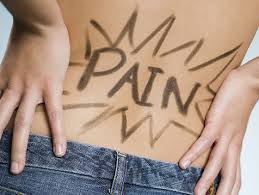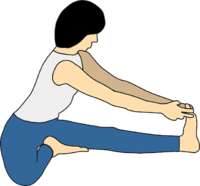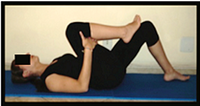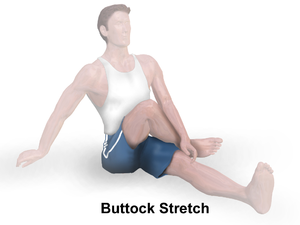Cyclist's Back
This article or area is currently under construction and may only be partially complete. Please come back soon to see the finished work! (26/08/2019)
Original Editor - Your name will be added here if you created the original content for this page.
Top Contributors - Lucinda hampton, Kim Jackson, Tony Lowe, Rachael Lowe and Chrysolite Jyothi Kommu
Description[edit | edit source]
Many cyclists suffer from pain in there backs. Compared to many sports, cycling is one with a relatively low injury rate (crashes and collisions apart) however cyclists do need to take care of their backs. Probably the most common complaint from cyclists is about pain in the back. The hunched over position on a road bike often takes its toll on the back. Low back pain is reported by more that 50% of cyclists.[1] Lower back pain causes the highest rates of functional impairment and medical attention amongst cycling overuse injuries. A 2010 article noting that future efforts to prevent overuse injuries in competitive cyclists should focus on lower back pain and anterior knee pain.[2]
Why do cyclists get low back pain[edit | edit source]
- Poor Bike Fit eg incorrect saddle height, uneven saddle
- Knee less than 25% bend at the end of the stroke forcing cyclist to rock there pelvis side to side to get sufficient power at bottom of stroke. Putting stress on low back muscles.
- Handlebars to far forward causing cyclist to over stretch the low back.
- Too much hip flexion, flexing lower back and causing core abdominal muscles to be in a poor position to work efficiently. (A longer crank may be needed.[3])
5. Back posture on the bicycle can strain the lower back (lumbar spine flexed) so a long time in the saddle can take its toll on the back.
6. Using big gears ie too slow cadence. Look for a cadence of 90 RPM. Extra stress at a lower cadence puts more stress on your back muscles.
7. Insufficient length of hamstrings, causing pulling on the pelvis and rotating the spine into flexion.
8. Insufficient core muscle strength putting more stress on the lower back.[4]
9. Position on the bicycle, with the neck arching back, can strain the neck and upper back, particularly so for cyclists with aerodynamic bars
10. Bumpy terrain increases jarring and compression to the spine, which can lead to back pain
11. Length of cycling done weekly. A 20110 study found that a significant difference existed between self-reported km cycled per week and LBP in recreational cyclists. Those cyclists who reported riding an average of 160 km or more per week were significantly more likely ( 3.6 times more likely) to report LBP than those who rode less km.[5]
Physiotherapy for Cyclists Back Pain[edit | edit source]
A good analysis of the cyclist (subjectively and objectively) should be undertaken both on and of the bike.
The Bike fit should be examined with cyclist in riding position. Subjective examination should include asking: does the rider cycle often and how far; has the routine changed; is it a new bike or been adjusted recently; what type of terrain and gradients are being ridden; what cadence is the cyclist doing.
A lumber Spinal assessment should be undertaken
Muscle lengths and power should be assessed in the major muscles involved in cycling
- core muscles ( A 2017 systematic review found that core muscle activation imbalances, back extensor endurance deficits, and increased lumbar flexion while cycling are often present in cyclists with low back pain.[6] )
- back extensors
- gluteal muscles
- hamstrings
- quadriceps
- latisimuss dorsi
- thoraco lumbar fascia
Treatment[edit | edit source]
Focus on the issues you identified in the examination. Remembering the most common fixes are
- Check the bike fit
- Check the cadence , seeing if it needs be increased.
- Strengthen the core and back extensors
- Improve flexibility and mobility
- Check the milage and check slow increase.[7]
- See if bumpy terrain is an issue. A good chamois in bike shorts and/or a gel seat cover can reduce the shock transmitted to the pelvis and spine.
- If an area of concern is identified in the spinal assessment as a cause eg stiff thoracic segment , treat as applicable.
NB If pain persists or any flags are indicated, always refer as needed.
Stretching[edit | edit source]
- Adding a stretching routine to any cyclists routine is ideal. See Stretching for great information re prescribing stretches. The most common muscles to include in a stretching routine to prevent back pain are shown in diagrams below
The video below shows the most commonly needed stretches for a cyclist to do. Of course add any that have been identified in your examination to the routine.
Conclusion[edit | edit source]
Cycling is a great exercise and most cyclists with low back pain can overcome this once the cause has been identified. Happy Cycling.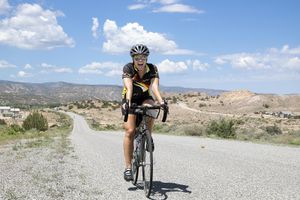
References[edit | edit source]
- ↑ Streisfeld GM, Bartoszek C, Creran E, Inge B, McShane MD, Johnston T. Relationship between body positioning, muscle activity, and spinal kinematics in cyclists with and without low back pain: a systematic review. Sports health. 2017 Jan;9(1):75-9. Available from: https://www.ncbi.nlm.nih.gov/pmc/articles/PMC5315261/ (accessed 23.8.2019)
- ↑ Clarsen, Benjamin & Krosshaug, Tron & Bahr, Roald. (2010). Overuse Injuries in Professional Road Cyclists. The American journal of sports medicine. 38. 2494-501. 10.1177/0363546510376816. Available from: https://www.researchgate.net/publication/46288399_Overuse_Injuries_in_Professional_Road_Cyclists (last accessed 24.8.2019)
- ↑ Bike Fit Advisor. Back Pain on the Bike // beyond "the bars are too low" Available from: https://www.youtube.com/watch?v=LszLxRZD8BU (last accessed 24.8.2019)
- ↑ Global Cycle Network. How to prevent lower back pain. Available from: https://www.youtube.com/watch?v=FAwwutF11Qg (last accessed 24.8.2019)
- ↑ Schultz SJ, Gordon SJ. Recreational cyclists: The relationship between low back pain and training characteristics. International journal of exercise science. 2010;3(3):79. Available from: https://www.ncbi.nlm.nih.gov/pmc/articles/PMC4738893/ (last accessed 24.8.2019)
- ↑ Streisfeld GM, Bartoszek C, Creran E, Inge B, McShane MD, Johnston T. Relationship between body positioning, muscle activity, and spinal kinematics in cyclists with and without low back pain: a systematic review. Sports health. 2017 Jan;9(1):75-9. Available from: https://www.ncbi.nlm.nih.gov/pmc/articles/PMC5315261/ ( accessed 24.8.2019)
- ↑ mapmyrun. 5 fixes for cycling related lower back pain. Available from: https://blog.mapmyrun.com/5-fixes-cycling-related-lower-back-pain/ ( last accessed 25.8.2019)
- ↑ Global Cycle Network. Top 5 Stretches To Do After A Ride | Cycling Fitness. Available from: https://www.youtube.com/watch?v=1VCM7xnL2QY&feature=youtu.be ( last accessed 25.8.2019)
